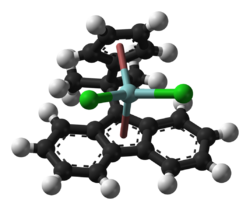Fluorene
Topic: Chemistry
 From HandWiki - Reading time: 4 min
From HandWiki - Reading time: 4 min

| |

| |

| |
| Names | |
|---|---|
| Preferred IUPAC name
9H-Fluorene[2] | |
| Systematic IUPAC name
Tricyclo[7.4.0.02,7]trideca-2,4,6,9,11,13-hexaene | |
| Identifiers | |
3D model (JSmol)
|
|
| ChEBI | |
| ChEMBL | |
| ChemSpider | |
| EC Number |
|
| KEGG | |
PubChem CID
|
|
| RTECS number |
|
| UNII | |
| |
| |
| Properties | |
| C13H10 | |
| Molar mass | 166.223 g·mol−1 |
| Density | 1.202 g/mL |
| Melting point | 116 to 117 °C (241 to 243 °F; 389 to 390 K) |
| Boiling point | 295 °C (563 °F; 568 K) |
| 1.992 mg/L | |
| Solubility | organic solvents |
| log P | 4.18 |
| Acidity (pKa) | 22.6 |
| -110.5·10−6 cm3/mol | |
| Hazards | |
| Safety data sheet | Sigma-Aldrich |
| NFPA 704 (fire diamond) | |
| Flash point | 152 °C (306 °F; 425 K) |
| Lethal dose or concentration (LD, LC): | |
LD50 (median dose)
|
16000 mg/kg (oral, rat) |
Except where otherwise noted, data are given for materials in their standard state (at 25 °C [77 °F], 100 kPa). | |
| Infobox references | |
Fluorene /ˈflʊəriːn/, or 9H-fluorene is an organic compound with the formula (C6H4)2CH2. It forms white crystals that exhibit a characteristic, aromatic odor similar to that of naphthalene. It has a violet fluorescence, hence its name. For commercial purposes it is obtained from coal tar.[3] It is insoluble in water and soluble in many organic solvents. Although sometimes classified as a polycyclic aromatic hydrocarbon, the five-membered ring has no aromatic properties. Fluorene is mildly acidic.
Synthesis, structure, and reactivity
Although fluorene is obtained from coal tar, it can also be prepared by dehydrogenation of diphenylmethane.[3] Alternatively, it can be prepared by the reduction of fluorenone with zinc[4] or hypophosphorous acid–iodine.[5] The fluorene molecule is nearly planar,[6] although each of the two benzene rings is coplanar with the central carbon 9.[7]
Fluorene can be found after the incomplete combustion of plastics such as PS, PE and PVC.[8]
Acidity
The C9-H sites of the fluorene ring are weakly acidic (pKa = 22.6 in DMSO.[9]) Deprotonation gives the stable fluorenyl anion, nominally C13H9−, which is aromatic and has an intense orange colour. The anion is a nucleophile. Electrophiles react with it by adding to the 9-position. The purification of fluorene exploits its acidity and the low solubility of its sodium derivative in hydrocarbon solvents.
Both protons can be removed from C9. For example, 9,9-fluorenyldipotassium can be obtained by treating fluorene with potassium metal in boiling dioxane.[10]
Ligand properties
Fluorene and its derivatives can be deprotonated to give ligands akin to cyclopentadienide.
Uses
Fluorene is a precursor to other fluorene compounds; the parent species has few applications. Fluorene-9-carboxylic acid is a precursor to pharmaceuticals. Oxidation of fluorene gives fluorenone, which is nitrated to give commercially useful derivatives. 9-Fluorenylmethyl chloroformate (Fmoc chloride) is used to introduce the 9-fluorenylmethyl carbamate (Fmoc) protecting group on amines in peptide synthesis.[3]
Polyfluorene polymers (where carbon 7 of one unit is linked to carbon 2 of the next one, displacing two hydrogens) are electrically conductive and electroluminescent, and have been much investigated as a luminophore in organic light-emitting diodes.
Fluorene dyes
Fluorene dyes are well developed. Most are prepared by condensation of the active methylene group with carbonyls. 2-Aminofluorene, 3,6-bis-(dimethylamino)fluorene, and 2,7-diiodofluorene are precursors to dyes.[12]
See also
References
- ↑ Merck Index, 11th Edition, 4081
- ↑ International Union of Pure and Applied Chemistry (2014). Nomenclature of Organic Chemistry: IUPAC Recommendations and Preferred Names 2013. The Royal Society of Chemistry. pp. 207. doi:10.1039/9781849733069. ISBN 978-0-85404-182-4.
- ↑ 3.0 3.1 3.2 Griesbaum, Karl; Behr, Arno; Biedenkapp, Dieter; Voges, Heinz-Werner; Garbe, Dorothea; Paetz, Christian; Collin, Gerd; Mayer, Dieter et al. (2000). "Ullmann's Encyclopedia of Industrial Chemistry". Ullmann's Encyclopedia of Industrial Chemistry. Weinheim: Wiley-VCH. doi:10.1002/14356007.a13_227.
- ↑ Fittig, Rud. (1873), "Ueber einen neuen Kohlenwasserstoff aus dem Diphenylenketon" Ber. Dtsch. Chem. Ges. volume 6, p. 187.doi:10.1002/cber.18730060169
- ↑ Hicks, Latorya D.; Han, Ja Kyung; Fry, Albert J. (2000). "Hypophosphorous acid–iodine: a novel reducing system.". Tetrahedron Letters (Elsevier BV) 41 (41): 7817–7820. doi:10.1016/s0040-4039(00)01359-9. ISSN 0040-4039.
- ↑ D. M. Burns, John Iball (1954), Molecular Structure of Fluorene Nature volume 173, p. 635. doi:10.1038/173635a0
- ↑ Gerkin, R. E.; Lundstedt, A. P.; Reppart, W. J. (1984). "Structure of fluorene, C13H10, at 159 K". Acta Crystallographica Section C Crystal Structure Communications 40 (11): 1892–1894. doi:10.1107/S0108270184009963.
- ↑ Wang, Zhenlei; Richter, Henning; Howard, Jack B.; Jordan, Jude; Carlson, Joel; Levendis, Yiannis A. (2004-06-01). "Laboratory Investigation of the Products of the Incomplete Combustion of Waste Plastics and Techniques for Their Minimization". Industrial & Engineering Chemistry Research 43 (12): 2873–2886. doi:10.1021/ie030477u. ISSN 0888-5885. https://doi.org/10.1021/ie030477u.
- ↑ F. G. Bordwell (1988). "Equilibrium acidities in dimethyl sulfoxide solution". Acc. Chem. Res. 21 (12): 456–463. doi:10.1021/ar00156a004.
- ↑ G. W. Scherf; R. K. Brown (1960). "Potassium Derivatives of Fluorene as Intermediates in the Preparation of C9-substituted Fluorenes. I. The Preparation of 9-fluorenyl Potassium and the Infrared Spectra of Fluorene and Some C9-substituted Fluorenes". Canadian Journal of Chemistry 38: 697. doi:10.1139/v60-100..
- ↑ Ewen, J. A.; Jones, R. L.; Razavi, A.; Ferrara, J. D. (1988). "Syndiospecific Propylene Polymerizations with Group IVB Metallocenes". Journal of the American Chemical Society 110 (18): 6255–6256. doi:10.1021/ja00226a056. PMID 22148816.
- ↑ Kurdyukova, I. V.; Ishchenko, A. A. (2012). "Organic dyes based on fluorene and its derivatives". Russian Chemical Reviews 81 (3): 258–290. doi:10.1070/RC2012v081n03ABEH004211. Bibcode: 2012RuCRv..81..258K.
External links
- Fluorene in the National Institute of Standards and Technology database.
 |
 KSF
KSF

